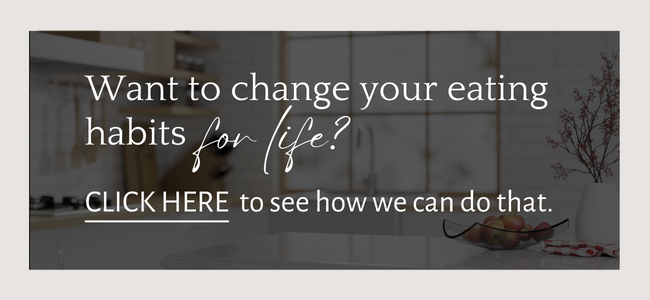Your Level of Belief
Your level of belief in your ability to reach your eating habit or weight loss goal may be what’s holding you back from the results you truly desire.
In this episode, I’m explaining belief as well as how it relates to different types of goals.
I’m also helping you determine your level of belief and how to move it along the belief spectrum.
Going from disbelief to partial belief that you’ll achieve even your biggest eating habit or weight loss goals.
Or, if you already are in partial belief, how you can step into full belief, so you have the BEST chance of reaching that seemingly impossible (but VERY possible) goal.
*To read the episode transcript, scroll to the bottom.
Listen Below:
Related Episodes:
Next Steps: Take Control of Your Eating Habits & Lose Weight Naturally
Imagine the freedom and peace of overcoming emotional eating, overeating, and mindless eating… so you can achieve lasting weight loss.
Ready to break free for good?
Together, we’ll create a personalized pathway that works for you. Bringing clarity, relief, and encouragement. Click the button to start.
Full Episode Transcript:
Your Level of Belief
Hi there, welcome to the podcast. I am so excited to be talking to you today about you. More specifically, your level of belief in yourself. Your capabilities, your potential, all the things.
I’m going to explain to you why belief in yourself is so crucial to getting the results that you want. Why disbelief, which can be sneaky, will end up sabotaging you and decreasing the likelihood that you’ll get the results you want.
Also, I’m going to help you to improve your level of belief by getting from disbelief to partial belief to full belief in yourself.
You might even be thinking right now that you are already in belief, but you’ll see that there are some sneaky ways that your brain is causing some self-doubt, which is disbelief.
That’s one of the things my clients and I work deeply on, because it really is so important. If you’re able to start clearing out some of those thoughts that lead to self-doubt or disbelief, you will start having a much easier time changing your eating habits.
Alright, so let’s just start by defining belief. So, the one that resonated the most with me was from the Merriam Webster dictionary and they define belief as “a state or habit of mind in which trust or confidence is placed in some person or thing.”
I love that they included that it was either a state of mind or a habit of mind, because yes, belief, can also be a mindset, which is something that is more habitual. Meaning, your default thinking or your thought habits form your mindset and there is such a thing as a belief mindset.
And to define mindset, mindset is just the way you think about yourself or anything in the world.
So, I want to start by asking you some questions.
Think about your eating habit or weight loss goal. What I want to ask you is this… is this your “playing it safe” goal? Or is this your dream goal? So, there is definitely a difference.
The “playing it safe” goal is the goal that you think you have a very high chance of reaching. The dream goal is something that feels a little bit more like a stretch goal or an impossible goal. You may have heard these terms before. Basically, what these mean is that only a small part of you thinks you can actually reach that goal, but it’s a goal that you really truly desire, so you’re willing to at least believe it’s a teeny bit possible for you to attain that goal.
Let me give you a couple of examples. So a “playing it safe” goal might look like this. You’ve lost 20 pounds in the past, therefore you’re going to set a goal of losing 20 pounds again. Your brain has evidence that you’ve done this already, so it believes that it is possible for you to do this again, and maybe even probable.
Meaning, likely to occur. By the way, are human brains love to base almost everything off of the past. Past successes, past failures, past experiences. It loves using the past as evidence for the future. This makes a little bit of sense but is very limiting.
It’s limiting, because if we only did things based on the past, we wouldn’t really get anywhere would we? The past would always be holding us back.
I don’t want to go down too much of a rabbit hole with that, so bringing it back to the “play it safe” goal looking like you’ve lost 20 pounds in the past, therefore you’re going to set a goal of losing 20 pounds again.
However, you’d really love to lose 50 pounds, so you can be the same weight that you were 20 years ago when you felt your best. And although you’d love to lose 50 pounds, you almost feel like it might be impossible for you to do that. So, it’s a dream goal, that definitely feels like a stretch and even a little bit impossible.
By impossible, I don’t mean literally impossible. I believe that pretty much anything is possible. Our brains just like to limit us and make us think that things are impossible. Just to keep us safe. And that’s why it loves to use the past as evidence, to keep us safe from doing too many new things or things that it worries could harm us.
Our brain is just a big worrier. I’m sure you’ve heard the term “nervous Nancy.” Or I think “nervous Nelly” was another one I’ve heard. I kind of feel like that would be a good nickname for our brains.
So, if your initial goal was more of a “play it safe” goal, then think about your dream goal. Your stretch goal. Your impossible goal. So, if you’re in a safe situation where you can think about that right now, just take a pause and do that. I’ll even give you a few seconds of awkward silence in this episode right now to do so.
Now, answer this. When you think about your dream goal, whether that be a particular eating habit goal such as freedom from emotional eating, or quitting sugar, or even a weight loss goal such as losing 50 pounds, what do you think the outcome will most likely be?
Meaning, do you think it’s possible that you can quit sugar, but most likely won’t sustain that? Do you think there’s no way you can quit sugar even though you’d love to? Do you think you can maybe lose 30 lbs., but not 50 lbs.? Do you think there’s no way you can get control of emotional eating because you haven’t been successful yet? Do you think you might be able to have some freedom from emotional eating, but not complete freedom?
Do you think that you could lose 75 pounds and your goal is only 50 pounds? Do you think that you could quit sugar completely by the end of the week if you wanted to? So what I’m asking is to think about what you believe is your reality. If you were to take your best guess at the outcome for whatever your goal is, what do you think that outcome most likely is?
Now again, if you’re in a safe situation where you can think about that right now, just take another pause and to do so and I’ll give you another few moments of awkward silence.
As you probably noticed, my examples I just gave as far as possible beliefs you might have, ranged from complete disbelief to full belief. Your level of belief will be somewhere in that range of course. It’s really just important to be aware of where your brain currently is, as far as that level of belief. There’s no wrong answer here. It’s just where you currently are. You don’t need to be in full belief. I’m going to help you get into full belief.
You don’t even need to be in partial belief. You can be in pure disbelief. If you’re in disbelief, don’t worry, because I’m going to tell you how to start getting into partial belief.
So I would even say rate yourself on a scale of 1 to 10, where you would say that your level of belief is. 10 would be 100% full belief, meaning you think reaching your dream goal is as good as done. 1 would be 100% disbelief. I’m going to go out on a limb here and say that probably the highest you’re rating it would be a 9, but let’s get that to a 10. I’m guessing most of you answering, are somewhere between a 4 and 6.
So if you rated lower than a four out of 10 and you feel that you have a fair amount of disbelief that you will reach your dream goal, no worries. What I don’t want, is for you to feel like you are starting from way behind or that there’s no hope. In fact, you are going to be the person who is going to notice the most results and notice the biggest difference in how you feel in your body when it comes to thinking about your goal.
If you’re middle of the road and rated yourself somewhere between 4-6, just have some comfort in knowing that there are a lot of people who have very similar thoughts as you and also a similar level of some belief, but also some disbelief.
If you’re on the upper end and rated yourself higher than a six out of 10, you’re so close. All you need is just to get a little bit more belief so that you can transition into full belief. You will definitely notice the difference, even if you feel like currently you’re doing pretty good in the belief department.
Awareness of that little bit of disbelief that you might not have realized you had, allows you to starting squashing that, so you can make much more headway with your eating habits or weight loss results.
As I mentioned in the beginning of the episode, the reason why disbelief is holding you back, even sort of sabotaging your efforts, is because when you don’t believe you’ll really hit your goal (whether it be your “play it safe” goal or your impossible or dream goal), your actions will reflect that.
You’ll either not do enough of the things that will create your results, or you’ll fall back into old habits much more easily because your brain is thinking, “well, what’s the use, I won’t be hitting that goal anyway.” It can be sneaky though and you oftentimes aren’t even aware of thoughts like that.Disbelief,
Disbelief, any amount of it, often results from your brain either using the past as evidence for what will potentially happen in the future.
Let me give you an example.
If you’ve tried to change your eating habits or lose weight in the past, but either didn’t succeed at all, only partially succeeded, or fully succeeded but then maybe gained some or all of the weight back, your human brain (everyone’s human brain) likes to use that as evidence for the future.
Meaning, it’ll tell you that the same thing will happen. It thinks it’s trying to protect you from the negative feelings you had in the past after you didn’t succeed or only partially succeeded. The human brain also loves to conserve energy, so if it can get out of doing something that it perceives will take some effort, it will.
So, I just want to be clear here, that does not mean YOU are lazy. It just means that your human brain was designed to be a little lazy, to conserve energy. Back in the cave man and cave woman days, this was crucial to survival. Conservation of energy as much as possible.
So, by default, it will look for any excuse possible NOT to do the hard thing. You must override its normal programming, to go forward with things many times, especially when it comes to dream goals or impossible goals.
That’s what we’re going to do by moving you from disbelief to partial belief to full belief.
The other reason why your brain tends to go into disbelief is a fear of failure. As humans, we feel best when we are accepted by our herd, our community. If we do something wrong, we could be seen as weak and potentially be kicked out of the herd (at least back in the cave man, cave woman days.)
So, it’s important for humans by default, to want to avoid failure, to avoid being seen as weak by others (and kicked out of the herd or community). Again, just a normal human brain thing that occurs because of the way our brains developed.
Alright, so that first step is to find out where exactly you are on that belief scale or belief spectrum. So, you have a starting point.
Next, you figure out where you want to be. That’s full belief, right? Full belief looks like this. So, if your dream goal is to lose 50 lbs. Full belief would be a thought like “Losing 50 lbs. is as good as done.” Or “I’m losing 50 lbs. no matter what.” “Or I’m fully capable and will lose 50 lbs.”
Whenever you are at one spot and you want to be in another spot, you need something to get you there, right? Kind of like a bridge. The same thing is true for belief. If you’re currently at disbelief and want to be in full belief, we need to get you a bridge that will take you to full belief.
That’s going to be a thought that is more believable to you right now, that moves you closer to that full belief thought.
Let me explain.
So if you’re currently thinking, “I can lose 30 lbs. because I’ve done it before, but I don’t know if I can lose 50 lbs.” And you want to have the full belief thought of, “I WILL lose 50 lbs.” What might be a thought that’s believable to you right now, that would bring you closer to that full belief thought? A thought that’s in between where you are now and where you want to be.
By the way, a term for this is a bridge thought. It bridges from where you are to where you want to be.
It might be something like, “I think it’s very possible for me to lose 50 lbs.” That’s it. It can be something as simple as believing in what’s possible for you.
Let me give you another example. If you’re currently thinking, “I can’t stop emotionally eating, but want to.” And you want to have the belief thought of “I will stop emotionally eating and never look back.” Find a thought that’s someplace in between that you can believe right now.
It might be something like, “I’m pretty sure with help, I can stop emotionally eating.” Right? It just has to be something that feels true to you right now but looking at the possibility.
Our brains like to look at past experiences and thinking what happened in the past, will happen again. Show your brain possibility though. Because you can’t reach your dream goals if you’re stuck in the past or with thoughts of disbelief.
So you’re going to take that thought that moves you closer to full belief, and practice this every day. Think it or say it out loud, at least once a day. So just write it down and put it in a place to remind you to think or say it. Easy!
Then, when you feel like that thought feels like it’s coming easily to you, think of the next thought that will bring you even closer to full belief. Maybe if your level of belief was already pretty close to full belief, your next thought will be a full belief thought.
The objective is to keep moving your level of belief closer and closer with thoughts (thoughts are just sentences in your head) that are practiced every day, that move you one step closer. Thoughts you can belief, but that make you feel like it’s possible, then probable, then as good as done.
Alright my lovelies, give it a try. I just want to leave you with this.
You are 100% capable of creating the results you want. Your belief of what’s possible for you, may be what’s holding you back. So, if you’re lacking some belief right now, no worries. I will hold full belief for you and help you to start feeling that belief yourself. In the meantime, give this simple exercise a try.
Take care and I’ll talk with you soon.


KATE JOHNSTON
Eating Habits & Weight Loss Coach
Helping career women break free from emotional eating, overeating and mindless eating.
Start feeling more healthy, confident and free by clicking the button below.

